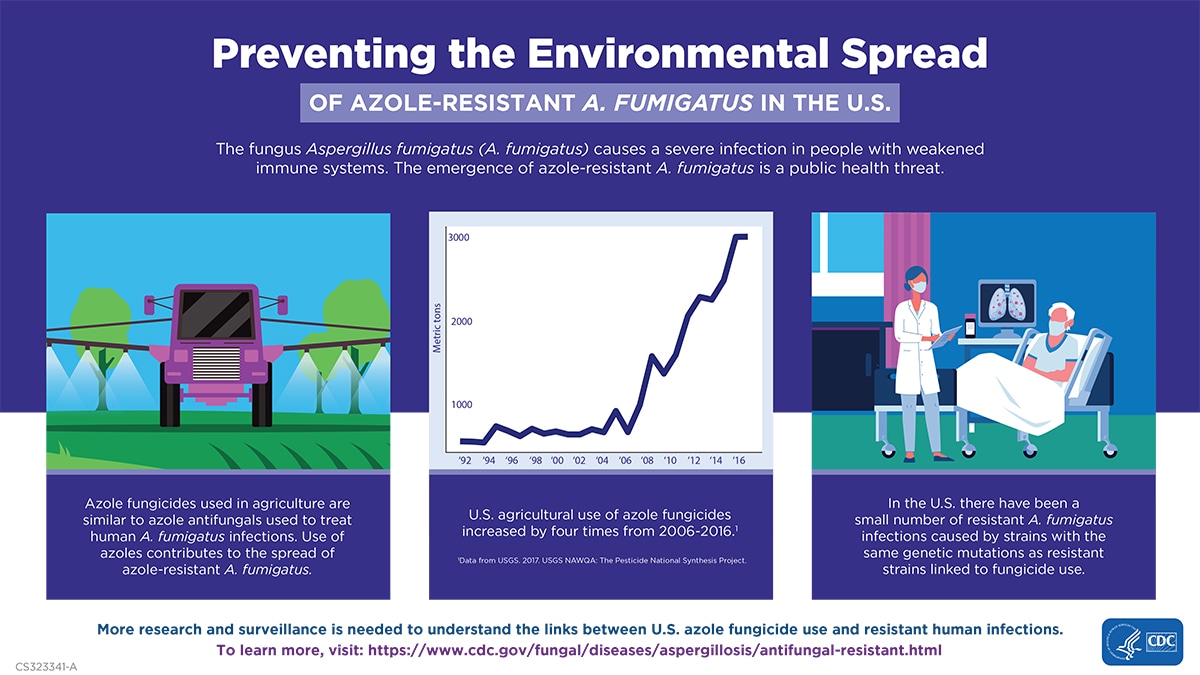At a glance
- Antimicrobial resistance occurs when bacteria and fungi are able to survive antimicrobial drugs.
- Emerging azole-resistant Aspergillus fumigatus (A. fumigatus) is a growing global public health concern.
- Azoles are the first line medication for people infected with A. fumigatus.

Background
Antimicrobial resistance is emerging in one type of Aspergillus species called Aspergillus fumigatus (A. fumigatus). This is a common mold in the environment and the leading cause of invasive mold infections in people. Antimicrobial resistance occurs when bacteria and fungi are able to survive the antimicrobial drugs that treat infections. As a result, the germs continue to grow.
Azole-resistant A. fumigatus is on the CDC 2019 Antibiotic Resistance Threats Report Watch List because it has the potential to rapidly spread.
Azole-resistant aspergillosis
A. fumigatus can result in infection, called aspergillosis, in people who have weakened immune systems, underlying diseases, or had transplants. Patients with severe cases of respiratory infections, like the flu or COVID-19, have also developed aspergillosis.
Triazole antifungal drugs, commonly called azoles, are the primary treatment for aspergillosis. Azole-resistant A. fumigatus infections are difficult to treat. These patients are up to 33% more likely to die than patients with infections that can be treated with azoles.
Emergence globally and within the United States
The true burden of azole-resistant aspergillosis in the United States is unknown. A few factors make it difficult to estimate:
- Aspergillosis is one of the leading missed diagnoses in intensive care units.
- Until recently, clinicians have had limited access to antifungal susceptibility testing.
An estimated 19% of A. fumigatus infections are resistant to azole antifungals in medical centers in some parts of the world. In a large U.S. study, antimicrobial resistance was identified in up to 7% of Aspergillus specimens from patients with stem cell and organ transplants.
Azole resistance develops in the body and in the environment
We know of two ways that A. fumigatus can develop resistance to azoles.
- Inside the body: Strains of A. fumigatus in people who take azole antifungals for a long period of time can become resistant, survive treatment, and continue to cause infection.
- Outside the body: Strains of A. fumigatus on decaying plants in the environment can be exposed to azole compounds used as fungicides that are chemically similar to azole antifungal medications. These strains can develop resistance to azoles.
Some patients with chronic A. fumigatus infections take azole antifungals over a long time.

Preventing the environmental spread of azole-resistant A. fumigatus in the US (PDF)
Azole fungicide use
Azole fungicides are used throughout the world to treat plant infections, prevent crop loss, and increase production. Patients with azole-resistant aspergillosis have been infected with A. fumigatus strains similar to those associated with agricultural azole fungicide use. Resistant Aspergillus infections are also found in people who have not taken azole antifungals.
A direct association between the quantity of U.S. agricultural azole fungicide use and human infections has not been established. The US Geological Survey estimated that the use of agricultural azole fungicide quadrupled from 2013 to 2016.
Interagency collaboration
The Framework for Interagency Collaboration to Review Potential Antibacterial and Antifungal Resistance Risks Associated with Pesticide Use was established in 2024. The framework outlines the process EPA, in collaboration with other federal agencies will take to assess the potential risks of pesticides.
- Berkow EL, Nunnally NS, Bandea A, Kuykendall R, Beer K, Lockhart SR. Detection of TR34/L98H CYP51A Mutation through Passive Surveillance for Azole-Resistant Aspergillus fumigatus in the United States from 2015 to 2017. Antimicrob Agents Chemother. 2018 Apr 26;62(5):e02240-17. doi: 10.1128/AAC.02240-17. PMID: 29463545; PMCID: PMC5923109.
- Beer KD, Farnon EC, Jain S, Jamerson C, Lineberger S, Miller J, et al. Multidrug-resistant Aspergillus fumigatus carrying mutations linked to environmental fungicide exposure — three states, 2010–2017. MMWR Morb Mortal Wkly Rep 201;67:1064–7.
- Lestrade PP, Bentvelsen RG, Schauwvlieghe AFAD, Sch 452 alekamp S, van der Velden WJFM, Kuiper EJ, et al. 2019. Voriconazole Resistance and Mortality in Invasive Aspergillosis: A Multicenter Retrospective Cohort Study. Clin Infect Dis 68:1463–1471; doi:10.1093/cid/ciy859.
- Brown GD, Denning DW, Gow NA, Levitz SM, Netea MG, White TC. Hidden killers: human fungal infections. Sci Transl Med 2012;4:165rv13.
- Baddley JW, Marr KA, Andes DR, Walsh TJ, Kaufman CA, Kontoyiannis DP, et al. Patterns of susceptibility of Aspergillus isolates recovered from patients enrolled in the Transplant-Associated Infection Surveillance Network. J Clin Microbiol 2009;47:3271–5.
- Kontoyiannis DP, Marr KA, Park BJ, Alexander BD, Anaissie EJ, Walsh TJ, et al. Prospective surveillance for invasive fungal infections in hematopoietic stem cell transplant recipients, 2001-2006: overview of the Transplant-Associated Infection Surveillance Network (TRANSNET) Database. Clin Infect Dis 2010;50:1091–100.
- Pappas PG, Alexander BD, Andes DR, Hadley S, Kauffman CA, Freifeld A, et al. Invasive fungal infections among organ transplant recipients: results of the Transplant-Associated Infection Surveillance Network (TRANSNET). Clin Infect Dis 2010;50:1101–11.
- Brauer VS, Rezende CP, Pessoni AM, De Paula RG, Rangappa KS, Nayaka SC, et al. Antifungal agents in agriculture: friends and foes of public health. Biomolecules 2019;9:521.
- Hurst SF, Berkow EL, Stevenson KL, Litvintseva AP, Lockhart SR. Isolation of azole-resistant Aspergillus fumigatus from the environment in the south-eastern USA. J Antimicrob Chemother 2017;72:2443–6.
- Snelders E, Camps SMT, Karawajczyk A, Schaftenaar G, Kema GHJ, van der Lee HA, et al. Triazole fungicides can induce cross-resistance to medical triazoles in Aspergillus fumigatus. PLoS One 2012;7:e31801.
- Verweij PE, Kema GH, Zwaan B, Melchers WJ. Triazole fungicides and the selection of resistance to medical triazoles in the opportunistic mould Aspergillus fumigatus. Pest Manag Sci 2013;69:165–70.
- Snelders E, Huis in 't Veld RAG, Rijs AJMM, Kema GHJ, Melchers WJG, Verweij PE. Possible environmental origin of resistance of Aspergillus fumigatus to medical triazoles. Appl Environ Microbiol 2009;75:4053–7.
- Toda Mitsuru, Beer Karlyn D., Kuivila Kathryn M., Chiller Tom M., Jackson Brendan R. Trends in Agricultural Triazole Fungicide Use in the United States, 1992–2016 and Possible Implications for Antifungal-Resistant Fungi in Human Disease. Environ Health Perspect 129:055001; doi:10.1289/EHP7484.
- Langfeldt A, Gold JAW, Chiller T. Emerging Fungal Infections: from the Fields to the Clinic, Resistant Aspergillus fumigatus and Dermatophyte Species: a One Health Perspective on an Urgent Public Health Problem. Curr Clin Micro Rpt (2022)
